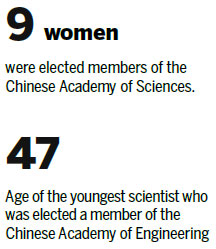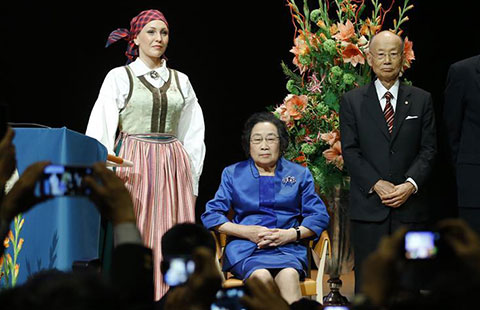131 elected members of top science academies
Updated: 2015-12-08 07:47
By Cheng Yingqi(China Daily)
|
||||||||
Researchers recognized for their new work on applied technologies
Scientists from innovative enterprises have been awarded the highest honor of the Chinese science community, representing new research directions in 3D printing, big data and next-generation Internet.
On Monday, the Chinese Academy of Sciences and the Chinese Academy of Engineering announced their new membership election. Sixty-one scientists were elected members of the science academy, and 70 were elected to the engineering academy.
The biennial election of academy members is the highest accolade for scientists in China.
Of the 70 new CAE members, 13 work for innovative enterprises, while the others are from universities, research institutes and hospitals.
For the first time, experts specializing in emerging industrial technologies such as 3D printing, big data and next-generation Internet won the honor.
Wang Endong, chief scientist at Inspur Group, a leading IT company in China, is one of them.
"Wang being selected was quite predicable as it indicates that we entrepreneurs are gradually becoming a main part of engineering projects," said Zuo Baichen, vice-president of the company.

"This is a recognition of the work we have done, and we now can have more resources to conduct our ongoing research."
Zuo also believes that the basic research currently based in academic institutions is being transferred to industrial research centers, most of which are headed by entrepreneurs or the private sector and are focused on applied science.
Han Jiecai, vice-president of the Harbin Institute of Technology, and a new member of CAS, said the academic system should embrace more scientific research elites from the business sector.
"Scientific exploration, starting businesses and expanding the industrial scale are three links on the chain of innovation. In the past, we have done well in the lab, but performed poorly in transferring the technology into industrial products," Han said.
"Strengthening research capacity inside innovative enterprises can shorten the process of technology transfer because it joins all the links together, so that the production department can communicate with the R&D department at the laboratory stage," he said.
Sun Yuan contributed to this story.
chengyingqi@chinadaily.com.cn

 US marks 74th anniversary of Pearl Harbor attacks
US marks 74th anniversary of Pearl Harbor attacks
 Christmas lights across the world's shopping districts
Christmas lights across the world's shopping districts
 Top 10 best airports where flight delays aren't a pain
Top 10 best airports where flight delays aren't a pain
 Beijing issues first-ever red alert as air pollution hits hazardous levels
Beijing issues first-ever red alert as air pollution hits hazardous levels
 China's Nobel laureate attends lecture in Karolinska Institute
China's Nobel laureate attends lecture in Karolinska Institute
 Families thanked for opening homes
Families thanked for opening homes
 The world in photos: November 30 - December 6
The world in photos: November 30 - December 6
 Riding with Santa Claus around the world
Riding with Santa Claus around the world
Most Viewed
Editor's Picks

|

|

|

|

|

|
Today's Top News
Shooting rampage at US social services agency leaves 14 dead
Chinese bargain hunters are changing the retail game
Chinese president arrives in Turkey for G20 summit
Islamic State claims responsibility for Paris attacks
Obama, Netanyahu at White House seek to mend US-Israel ties
China, not Canada, is top US trade partner
Tu first Chinese to win Nobel Prize in Medicine
Huntsman says Sino-US relationship needs common goals
US Weekly

|

|








